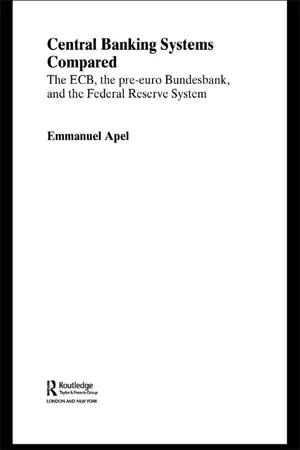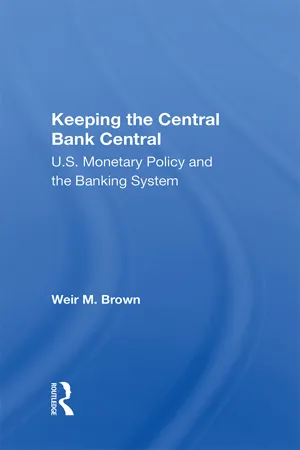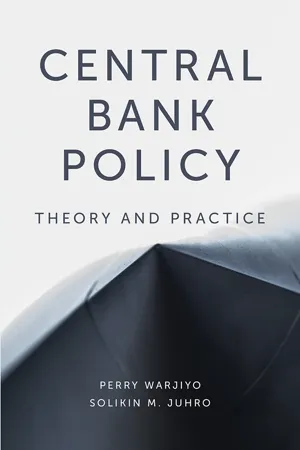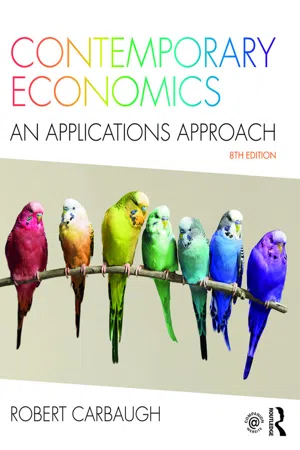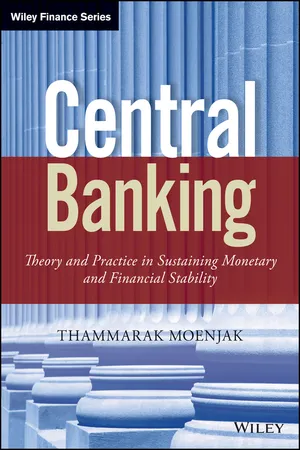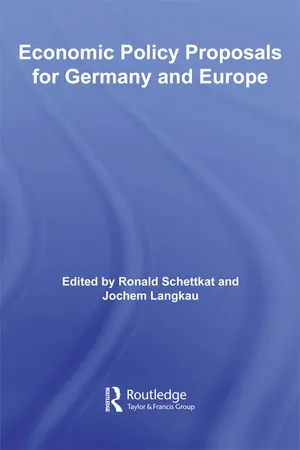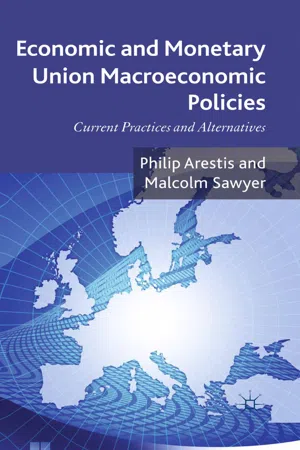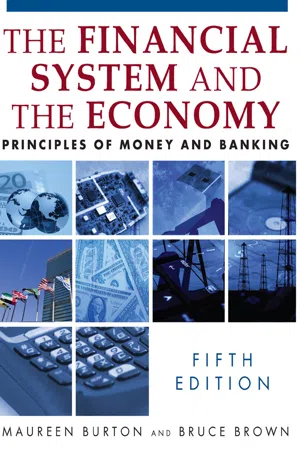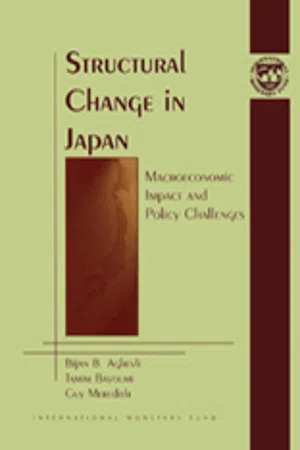Economics
Monetary Policy Actions in the Short run
Monetary policy actions in the short run refer to the measures taken by a central bank to influence the money supply, interest rates, and overall economic activity. These actions can include changes in the central bank's target interest rate, open market operations, and reserve requirements for banks. The goal is to stabilize prices, promote full employment, and support economic growth in the short term.
Written by Perlego with AI-assistance
Related key terms
12 Key excerpts on "Monetary Policy Actions in the Short run"
- eBook - ePub
- Emmanuel Apel(Author)
- 2003(Publication Date)
- Routledge(Publisher)
3 Monetary policy Strategy, instruments and actions A central bank is assigned an objective, or objectives, to achieve and maintain. To achieve the objective, or objectives, the central bank’s decisionmaking body usually defines a set of procedures to guide its actions. This set of procedures is called the monetary policy strateg y. The pre-euro Bun-desbankused a monetary policy strategy that is called ‘monetary targeting’. Under such a strategy, the central bank chooses a monetary aggregate and determines its monetary policy actions on the basis of comparisons between the target value of the monetary aggregate and the actual value of the monetary aggregate. The target value of the monetary aggregate must be defined so as to be consistent with the central bank’s definition of the ‘price stability’ objective. Another well-known and widely used (Bank of Canada, Bank of England) monetary policy strategy is the ‘inflation targeting’ strategy. Under such a strategy, the central bank’s decision-making body takes monetary policy actions on the basis of a comparison between the target for inflation and the forecast inflation rate. The monetary authority steers the final target variable (the policy objective of ‘price stability’) directly without the use of a separate intermediate target variable, such as the ‘monetary target’. The inflation targeting strategy requires an inflation forecast since monetary policy actions (i.e. changing short-term interest rates) affect the final objective with a lag. The inflation forecast is usually based on a wide range of economic and financial variables to estimate, for example, the future ‘output gap’, which has an impact on price developments - eBook - ePub
Keeping The Central Bank Central
U.S. Monetary Policy And The Banking System
- Weir B Brown(Author)
- 2019(Publication Date)
- Routledge(Publisher)
3 Effects on the Conduct of Monetary PolicyThe first necessity of a Central Bank ... is to make sure that it has an unchallengeable control over the total volume of bank-money created by its Member Banks. . . . The first question, therefore, is how the Central Bank can control the amount of its Member Banks' Reserves.—John Maynard Keynes, A Treatise on MoneyWhat the monetary authorities strive to promote by the means at their disposal is a sounder and more stable economy. . . . Money and credit are only a means to an end.—E. A. Goldenweiser, American Monetary PolicyThe conduct of United States monetary policy is an ongoing, dynamic process involving the Federal Reserve System and its constituent bodies on the one hand and the banking system and related money-market institutions on the other. Policy objectives conceived by the Fed are carried out by means of measures, ad hoc or continuing ones, that affect the banks. There is both a reciprocal aspect in the relationship, and one of driver-and-vehicle. In the latter sense, the banking system is an instrument panel containing gauges and indicators that help to register the economy's approximate speed, temperature, and remaining fuel, as well as the levers and control buttons to accelerate or retard the pace or to modify direction.While there are other important factors endogenous to the U.S. economic model that affect the evolution of nominal GNP besides those involving actions of the Federal Reserve and the banks, of course, the proper relationship between the commercial banking system and the Federal Reserve's operating controls is a necessary, if not sufficient, requisite for effective monetary policy. The rational or optimum relationship can hardly be expected to remain static, since structural as well as operating mutations occur on both sides of this interface. The goal might be stated as that of making sure that both the indicating gauges and the control buttons are progressively adapted, pari passu - eBook - ePub
The Chinese Macroeconomy and Financial System
A U.S. Perspective
- Ronald M Schramm(Author)
- 2015(Publication Date)
- Routledge(Publisher)
8 Monetary Policy in Action慈不掌兵, 义不掌财Neither Controlling an Army nor Controlling Finances is for the TimidThe tools mentioned in the last chapter are used to impact economic performance in a positive direction. Figure 8.1 provides the traditional mechanism by which monetary policy works—what is known as the transmissions mechanism. It also depicts the enhanced set of tools and goals included in China’s monetary policy (note that enhancements are shaded). Clearly, the transmission mechanism in China is even more complex than the traditional one since it includes multiple tools and goals. In this chapter, we will explain why. The transmissions mechanism represents a chain of actions and outcomes, starting with the central bank trying to either stimulate or slow the economy using policy tools.Source: Author created.The traditional transmission mechanism in the United States and the more complex mechanism in China (shaded text indicates additional tools/targets in China).Figure 8.1The initial policy action typically impacts bank reserves, which in turn impact the short-term interest rates that banks charge each other (the interbank market rate), as well as longer-term interest rates—and end users. China’s transmission system also affects the availability of credit—influencing the size of the loan or even the possibility that a loan application is turned down. As these types of lending constraints are passed on to companies and consumers within the economy, their decisions to purchase investment goods or consumer goods are affected. This in turn impacts overall economic activity.The transmission mechanism can be shown graphically by using the investment–savings/liquidity–money demand (IS/LM) framework found in Chapter 9 and described in Figure 8.2 - eBook - ePub
Central Bank Policy
Theory and Practice
- Perry Warjiyo, Solikin M. Juhro(Authors)
- 2019(Publication Date)
- Emerald Publishing Limited(Publisher)
The central bank implements its monetary policy stance by influencing interest rates (and liquidity) on the money market, which is subsequently transmitted to term deposit rates, lending rates and interest rates on other financial assets, thus affecting aggregate demand, output, and inflation. Nevertheless, the effectiveness of monetary policy transmission through the interest rate channel depends on banking and financial sector efficiency. Operating costs, profit margin, and the risk premium affect the magnitude of spread between lending and funding rates (demand deposits, savings deposits, and demand deposits) as well as money market rates. Therefore, market deepening efforts to boost efficiency are required to narrow the interest rate spread, including regulations concerning transparency and market conduct for banks and other financial institutions when setting interest rates. Third, bank regulatory policy plays a salient role in terms of strengthening the use of traditional monetary instruments to influence lending. In addition to the interest rate and reserve requirement as monetary instruments, bank regulations on capital, liquidity, profitability, and loan loss provisions have a significant impact on credit. Furthermore, development of the credit information system is also important to reduce the problem of asymmetric information faced by banks when disbursing loans. It is important to stress that bank regulatory policy, in terms of monetary policy, must be based on bank behavior theory. The application of an inappropriate approach will be inefficient (pareto) and also counterproductive, which could actually exacerbate the risks faced by the banking industry. If banking supervision and monetary policy are conducted separately by two institutions, sound coordination is required between the two - Available until 20 Jul |Learn more
Contemporary Economics
An Applications Approach
- Robert Carbaugh(Author)
- 2016(Publication Date)
- Routledge(Publisher)
Having restored confidence in the financial system, the Fed turned its attention to the disaster’s impact on the economy. The Fed quickly cut the federal funds rate, its target for short-term interest rates, by 0.5 percentage point. Several large U.S. commercial banks responded to the Fed rate by reducing their lending rates to business and household customers.As the situation eased, the Fed kept the financial system flush with cash but at much lower levels than in previous days. Although the United States had suffered a major blow, the financial system proved to be quite resilient with markets and companies functioning better than one might expect.Check Point
- Describe the nature and operation of monetary policy.
- Identify the instruments that the Fed uses to control the money supply.
- Discuss how changes in the money supply by the Fed can result in changes in output, employment, and prices.
- How would the Fed combat a recession in the economy? How about inflation?
Monetary Policy: Advantages and Disadvantages
Most economists consider monetary policy to be an important tool for stabilizing the economy. Let us evaluate how well monetary policy works.Advantages of Monetary Policy
One strength of monetary policy is that it interferes very little with the freedom of the market, although market imperfections sometimes intensify the effects of policy upon particular sectors of the economy. A restrictive monetary policy cuts down the rate at which total spending can increase, but it does not dictate which particular expenditures must be slowed or reduced. If a restrictive monetary policy forces interest rates up from 6 percent to 8 percent, for example, you, the typical consumer, still have the option of borrowing money to purchase a new home, a car, or a major appliance. The expenditures that you cut in response to higher borrowing costs are the ones to which you attach the lowest priorities. Similarly, an expansionary monetary policy stimulates total spending, but the market also dictates its form.Another strength is that monetary policy is flexible. The FOMC usually meets about every six weeks, reaches a decision, and acts on that decision immediately. Moreover, the FOMC can call extraordinary meetings if economic events require it. In contrast, the application of fiscal policy may be postponed for many months by congressional deliberations. - eBook - ePub
Central Banking
Theory and Practice in Sustaining Monetary and Financial Stability
- Thammarak Moenjak(Author)
- 2014(Publication Date)
- Wiley(Publisher)
In practice, if inflation and GDP growth forecasts are projected to diverge much from a so-called acceptable (or target) range, it would be a signal for the central bank to reconsider its monetary policy stance. Whether the central bank will actually change monetary policy stance will also depend on the policy makers’ judgment, as it is usually accepted that even the most sophisticated macroeconomic models cannot capture the full complexity of the economy, and thus forecasts from the models can have a certain degree of error.SUMMARY
Changes in real interest rates can affect saving and investment decisions of households and firms, and thus economic activity, inflation, and employment.Monetary policy can affect household spending and saving decisions via six main effects, namely (1) the intertemporal substitution effect, (2) the income effect, (3) the wealth effect, (4) the exchange rate effect, (5) the expectations effect, and (6) second-round effects.Monetary policy can affect firms’ spending, saving, and investment behavior through five key effects, namely (1) the funding costs effect, (2) the asset price effect, (3) the exchange rate effect, (4) the expectations effect, and (5) second-round effects.The effects of monetary policy on households’ and firms’ consumption and investment decisions can transmit through the credit channel and the balance sheet channel - eBook - ePub
- Ronald Schettkat, Jochem Langkau(Authors)
- 2008(Publication Date)
- Routledge(Publisher)
3 Monetary policy and the real economyPaul De Grauwe and Cláudia Costa Storti
Introduction
How effective is monetary policy in influencing output and employment? How long do the effects of monetary policy last? These questions have been hotly debated. In the 1970s and 1980s, they led to a major schism in the economics profession between Monetarists and Keynesians. This schism seems to have been resolved now, and a mainstream view can be said to have emerged.The mainstream view today has been influenced by several theoretical developments. First, there is the real business cycle theory, which has introduced the idea that macroeconomic models should be based on sound micro-foundations in which individual agents continuously maximize their utilities in a dynamic framework and in which these agents understand and use the full complexity of the underlying model in forecasting the future (rational expectations). Second, building on this methodological innovation, macroeconomists have introduced price and wage rigidities into their models. This has led to the so-called Neo-Keynesian models in which representative agents optimize their utilities and have rational expectations but face some constraints in that they cannot adjust prices and wages instantaneously (see e.g. Clarida et al. 1999; Christiano et al. 2001). This last feature provides the basis for monetary policy to affect output and employment.These theoretical developments have led to the consensus view, first, that monetary policy has significant short-term effects on output and employment; second, that these effects are temporary. This consensus can be represented by a hump-shaped curve showing the time profile of the effect of an unexpected decline in the short-term interest rate on output. This curve is typically obtained from an impulse response analysis of the effect of an unanticipated decline in the short-term interest rate in an empirical version of Neo-Keynesian macroeconomic models (see e.g. Smets and Wouters 2003; Walsh 2003). Much of the discussion, today, among macroeconomists has shifted to the issue of whether this empirical regularity can be exploited by the monetary authorities and whether rules should govern the conduct of monetary policy. - Richard Coghlan(Author)
- 2014(Publication Date)
- Routledge(Publisher)
Chapter 5 . For the moment it is convenient to assume that they are the same. Monetary policy under this definition, therefore, consists of separate policy measures determining the supply of money relative to other public sector debt.The present approach suggests that this type of dichotomous treatment may be somewhat misleading. In this model monetary policy is largely concerned with influencing the demands for and supplies of credit in the economy, and the PSBR fits naturally within this category. It is, therefore, necessary to consider whether the PSBR might not be better considered as part of monetary policy than of fiscal policy. There is not really any separate exogenous monetary policy under which the authorities can guarantee perfect control of the money supply in any meaningful sense. That is a standard myth of macroeconomics, adopted by most monetarists and many Keynesians. The money supply, and consequently aggregate demand, can be much more easily controlled with a low PSBR than a high one. It does depend, however, on the total demands for finance from other sources, and there may well be circumstances, as noted above, when demand is severely depressed, in which an expansionary monetary policy requires the support of an expansionary PSBR.Within this model, macroeconomic policy, in the sense of aggregate demand management, operates mainly through the supply of money and changes in interest rates. Changes in government expenditure and the income tax rate will also have a separate effect on private sector expenditure, but the money supply and interest rates are the channels through which changes in the PSBR have their effect. It might, therefore, be more sensible to refer to the direct effect of a change in government expenditure or tax rates as fiscal policy, and the extent to which these changes influence the PSBR as part of monetary policy.- eBook - ePub
Economic and Monetary Union Macroeconomic Policies
Current Practices and Alternatives
- P. Arestis, Kenneth A. Loparo(Authors)
- 2013(Publication Date)
- Palgrave Macmillan(Publisher)
Another development worth mentioning is the pledge of €200 billion to the IMF by the EMU country-members to deal with the crisis. This amount is clearly not enough but the hope is that other countries outside the euro area would follow.4.3 InflationIt is clear that the only policy instrument which seeks to address inflation is that of monetary policy and that the prime objective of monetary policy is low inflation (with a target of below but near to 2 per cent). It is evident (by reference to our discussion in chapter 3 ) that the theoretical framework suggests that there are three sources of inflationary pressures, namely high level of demand (positive output gap), expectations of inflation and random supply-side shocks. The third of these can in effect be ignored within that framework since by assumption of their randomness they average out at zero. In that framework then monetary policy can be seen to address inflation in two ways. First, by varying the rate of interest the level of demand is influenced, which will in turn influence the rate of inflation. Second, it is hoped that by establishing a ‘credible’ and independent central bank with the objective of low inflation and the generated perception that the Monetary Policy Committee will be committed to the achievement of low inflation, relevant expectations will be generated that inflation is and will remain low.The role of supply-side shocks reveals a significant weakness in this approach to the control of inflation in that there is little monetary policy (or indeed any demand approach to inflation) can do in the face of supply-side shocks, whether positive or negative. When there are substantial shocks to inflation from outside the economy, as evidenced by events in 2008, then the only policy which is available is to declare that these cost and price rises are a passing event and to reassert commitment to low inflation in the hope that the price rises not only prove to be temporary but also that they do not feed through into expectations about inflation, the so-called ‘second round’ effects. - eBook - ePub
The Financial System and the Economy
Principles of Money and Banking
- Maureen Burton, Bruce Brown(Authors)
- 2014(Publication Date)
- Routledge(Publisher)
1The time between the point when the need for action is recognized and the point when an adjustment policy is decided on and set in motion.Policy LagResolving these questions takes time, however. The net result is that policy actions can be paralyzed for a while, and policy makers may do too little too late. In any event, the policy-making process includes apolicy lag—the time between the point when the need for action is recognized and the point when an adjustment policy is decided upon and set in motion.From Action to Effect
When policy makers act, does the economy respond immediately? In general, the answer is no. The policy action will set in motion a series of adjustments in the economy that will gradually alter the performance of the economy relative to what it would have been in the absence of any new policy actions. To illustrate, suppose that the economy has been growing quickly with inflation accelerating, and the Fed decides to pursue a more restrictive monetary policy. To cut the growth in aggregate demand, the Fed takes actions that reduce the supply of funds, and interest rates rise. Will firms cut their investment spending right away? Not necessarily. If a new plant is half completed, capacity utilization in its existing plants is high, and the demand for a firm’s products is expected to remain fairly strong for the foreseeable future, then the firm (and other firms like it) will continue spending on investment projects. Gradually, however, as the rise in interest rates and reduction in the availability of funds slow the growth of aggregate demand, sales and capacity utilization will fall, and expectations about the future will be modified. At this point, investment spending plans will be reevaluated and possibly postponed or canceled, leading to a further deceleration in the growth of aggregate demand. - Ashima Goyal(Author)
- 2016(Publication Date)
- Routledge India(Publisher)
1 are used to assess the relative effectiveness of monetary and fiscal policy for stabilisation in response to temporary and permanent shocks, before concluding with some discussion of the limitations of and historical experience with fiscal and monetary policy. Assessment of their relation evolved over time. For example, fixed exchange rates fitted well with Keynesian sticky prices and led to an emphasis on fiscal policy in a closed economy. In general, to the extent the long run affects the short run, degrees of freedom for short-run policy are reduced.The remainder of the chapter is structured as follows: Section 8.2 examines the relative effectiveness of fiscal and monetary policy under static exchange rate expectations, while Section 8.3 extends the analysis to non-static exchange rate expectations. Section 8.4 turns to an assessment of fiscal and monetary policy, and Section 8.5 assesses the effect of the exchange rate on the current account before Section 8.6 summarises and concludes.8.2 Relative effectiveness of fiscal and monetary policy
If shocks cause output to deviate from full employment values, can macroeconomic policy bring output back to optimal values? And if so, which policy is more effective? These fundamental stabilisation issues are taken up in this section.8.2.1 Output market equilibrium
Output is demand determined in the short run. The components of aggregate demand are consumption (C ), investment (I ), government expenditure (G ) and net exports (NX). Consumption rises with output, net of taxation T , investment falls with the real interest rate and NX rises as real depreciation encourages exports and falls as higher domestic income raises imports.The open economy demand equals supply identity and becomes an equilibrium condition determining output, once the underlying determinants of demand or expenditure E are added. The signs below give the direction of the effect:
This can be written as:E t= C+ I(+Y t−T t)+(−R t−π t e)+ N XG t+(),S tP t ∗P tY t−T t+ −(8.1) Y t= E()Y t,R t−π t e,G t,T t,S tP t ∗P t+ − + − +(8.2) In addition to the causal variables shown for the components of aggregate demand, output (Y ) can also affect investment (I ) and the real interest rate (R – πe ) affects consumption (C- Tamim Bayoumi, Guy Meredith, and Bijan Aghevli(Authors)
- 1998(Publication Date)
- INTERNATIONAL MONETARY FUND(Publisher)
The decision to eliminate the use of direct credit controls as an instrument of policy was, in large part, the result of financial market liberalization. In particular, the private sector’s access to credit from financial institutions that were not subject to “guidance” began to increase, so that the impact on overall credit conditions of measures that only affected the banks began to diminish. 7 Following the first oil price shock, the Bank of Japan explicitly shifted the focus of policy to M2 (subsequently to M2+CDs—broad money and certificate of deposits), and quarterly projections of the money supply began to be published in 1978. 8 These quarterly projections were not strict monetary targets, and a number of observers have noted that there is limited evidence to suggest that the stance of monetary policy was altered in response to differences between the actual and projected levels of the money supply. 9 Indeed, with the financial market liberalization and innovation that began in the mid-1980s, monetary aggregates became more volatile and thus less useful as leading indicators. As a result, the Bank of Japan further downgraded monetary aggregates as a guide for policy. Nonetheless, considerable attention continues to be paid to monetary aggregates, and the Bank of Japan’s statements that have accompanied interest rate cuts during 1995 referred to the sluggishness in money growth as a factor influencing interest rate policy. Despite these changes, the Bank of Japan has consistently laid a strong emphasis on short-term interest rates as a day-to-day focus of monetary policy. 10 In terms of the discussion above, the level of short-term interest rates has been the operating target for policy
Learn about this page
Index pages curate the most relevant extracts from our library of academic textbooks. They’ve been created using an in-house natural language model (NLM), each adding context and meaning to key research topics.
